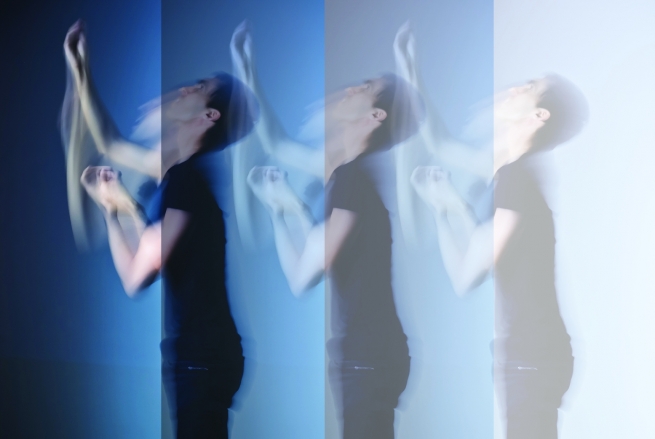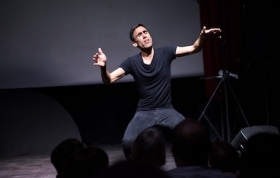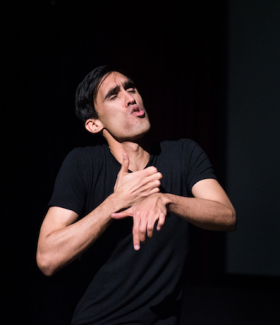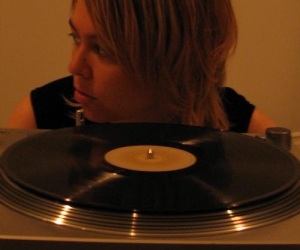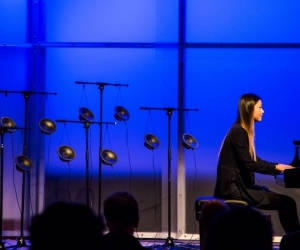After experiencing Anthropologies Imaginaires, it’s hard to imagine that just a few years ago Gabriel Dharmoo, its creator and performer, was reluctant to use his spectacularly flexible voice to anything like its full extent.
In fact, he initially rebelled against seizing the singer’s usual place, smack in the middle of the spotlight. “I felt like I was taking a lot of space, because people are always drawn to the voice—to its theatricality and all that,” recalls the Montreal-based singer, composer, and interdisciplinary artist, in a telephone interview from his home. “But I was scared of appearing like I wanted to be seen, and uncomfortable with the power of the voice.”
“So what I often did when I would improvise with others was be more textural. I was trying to hide, a little bit, but eventually I was like, ‘Just do it. You know you’ll be uncomfortable if you’re out there alone, but there’s no spotlight to steal. You’re the one that matters.’”
The trigger for this liberation was taking a Conservatoire de musique de Montréal course in improvisation with guitarist and composer René Lussier. “René was very good at helping me find more confidence,” Dharmoo says. “It’s not so much that I was shy, ’cause I’m not a shy person, but I think I was always in my head. I would do textures, but not really project in a soloistic way.”
Hearing the fearless English vocal improviser Phil Minton was a particular turning point. “That kind of validated it,” Dharmoo recalls. “‘This is something people do. They can be on CDs!’ So from there I really dove into it.”
An excursion to London to study with Minton led to further work with avant-garde singers Ute Wasserman and Christian Zehnder, and to Dharmoo’s discovery of a workable personal style. “I’d been really interested in hearing how other improvisers improvise, so that trip with Phil and Ute was really good. It was super humbling, in a way, because you’re like ‘Wow! They’re awesome!’ And it was also super motivating, because you find that, yeah, you can’t do this thing, but they can’t do this other thing. You discover your own idiosyncrasies, the things that are your own.”
Dharmoo had already accumulated a number of idiosyncrasies and influences. Prior to his European sojourn, he’d studied the Carnatic music of southern India, whose characteristic melodic elisions and rhythmic subdivisions gave him the tools with which to distinguish himself. “The way that I play with melody and ornamentation comes from learning Indian music and deconstructing it,” he notes. “That kind of singing has really bled into how I improvise. And that’s something I didn’t hear Phil Minton doing. I knew that was my area of uniqueness, I guess, and that I should cultivate it more.”
Dharmoo’s relationship with the Carnatic style is not uncomplicated. He has a connection to the subcontinent by ancestry. His Trinidad-born father was a child of the Indian diaspora that settled the Caribbean during colonial times. But his mother is French Canadian, and his early years in music were spent studying the cello, a very European device. He’s drawn to Carnatic music as a primary source, and he loves its complexity; but he also realizes that he can never be fully of that culture—it’s something admired and yearned for, but forever just out of reach.
“I went [to southern India] twice, in 2008 and 2011, and the point of those trips was to research a new form of music so that it would seed my practice in new music and composition,” he explains. “That’s how I initially saw it, but it proved much more than that.
“It was never like I was going to apply this raga behaviour exactly, or that rhythmic touch,” he continues. “I didn’t feel comfortable doing that, ‘cause I knew I wasn’t a specialist. It was more like, ‘How do I digest this?’”
Dharmoo’s Vaai Irandu, which was premiered by mezzo-soprano Michele Motard in 2010, was perhaps a template for Anthopologies Imaginares in both a positive and a negative sense.
“It’s a solo vocal piece with a drone, and the way the singer sings and the types of ornaments and glides were very much inspired by Carnatic music,” Dharmoo explains. “But I had another parallel research, which was more about my vocal improv, extended-voice techniques. There were clicks and pops that were superimposed through the melodic line, so people wondered, ‘Are these meant to invoke the tabla, or do they also sing like that in India?’
“I felt a bit uncomfortable with that kind of branding, you know: ‘This is the Indian guy that’s been to India.’”
In other words, audiences looked at this young brown man and thought they knew what they were seeing—and hearing. In Anthropologies Imaginaires, however, Dharmoo’s gripping and hilarious pseudo-ethnological arias cast a far wider net, drawing on “tribal” constructions that touch on central Africa, martial arts training, and American Idol. And then he’s had the genius idea of framing them with on-screen “analysis” from an assortment of mock-anthropologist talking heads. No one depicted on stage, whether live or prerecorded, is quite who they seem—which, for Dharmoo, might be an essential part of modern existence.
It’s certainly part of his.
“I wanted to use my own ambiguity, because I’m mixed race,” he says. “I could pretend to be anything else, and maybe people wouldn’t challenge it. Anthropologies is about otherness and imagination, and I think if someone else did that project it might be more problematic than it is.
“The piece is clearly a satire: people laugh a lot,” he adds. “But I’ve had people say that they could see it was funny, but they couldn’t laugh. Like, ‘This is too serious for me to be laughing,’ or whatever. So I think the piece kind of manages that ambiguity, where it’s satirical, and you laugh—but you still see some sort of intelligence to it, I guess, or discourse.”
The general consensus is that Anthropologies Imaginaires is as physically compelling as it is intellectually provocative. Over the course of several vignettes, Dharmoo shapeshifts his way in and out of character, taking a playful delight in sound one minute and then aping the martinet manners of a political demagogue the next.
“It’s very organic,” he says, when asked if he had choreographic help with his staging. “There’s eleven populations, and I tried to give each their own body language. Some of it is about how you would carry yourself visually, but some of it is more like how you would move in a specific art form. So dance is part of it, but it’s very linked to how I sing, and it’s not choreographed.
“When I improvise outside of that project I think I move with the sounds as well. I’m very interested in Carnatic singers—how they move their hands: it’s kind of like drawing the melody, or sculpting it, and I find I move like that. It’s like the haptic side of sound, the handling of the curves or the different kinds of textures that come out.”
With Anthropologies Imaginaires now in motion, what’s next for Dharmoo?
“I love Anthropologies, but if I could find one flaw about it, it’s that I wonder, Can I do this piece in India? or, Can I do this piece on a reserve?’ I still feel that it’s for the art world, the Western art world. So I want to go back to my real cultural baggage.
“The next work will be about brownness,” he continues, laughing. “It will be about mixed race, mixed identity, mixed cultural references. How I would define it now, in a kind of vague and safe way, is that I want to play with very symbolic cult songs, or cult aspects of Indian and nonresident Indian life, like in the South Asian diaspora in the U.K. or the U.S. or Canada. Old film songs that everyone in India would know and Carnatic music and people like M.I.A. or Das Racist—like, really high-art–low-art references.”
Dharmoo might cover the aforementioned songs relatively faithfully or “shred” into them with extended techniques. He’s also thinking of framing his next stage creation as a kind of lecture-demonstration, as is currently popular in performance art. And he’s definitely going to mess with the art-music notion that everybody knows their Wolfgang Amadeus Mozart and their Giuseppi Verdi.
“I want to do something where, if half the audience was South Asian and half was whoever showed up, the South Asians would really get it,” he says. “But it won’t be like ‘Okay, you white people, you’re not going to get this.’ It’s more like ‘Hey, how does that feel?’”
If past work is any indication, it’s going to feel both provocative and surprising. And, it might also leave listeners of all stripes more in love with the world, in all its diversity, than when they went in. Part of Anthropologies Imaginaires’ success is that it asks audiences to drop their filters, and this seems to be built into everything Dharmoo does.
“I’d phrase that as a question: What is normal music?” he says. “What do we accept as being beautiful music? What do we accept as valuable music, or valuable ways of singing? People sing differently, and that’s just how it is. And we should value that.”
FYI: Gabriel Dharmoo presents Anthropologies Imaginaires at Sound Symposium on July 14, 2016, in St. John's, and at SummerWorks in Toronto (August 4-14, several performances).
Top photo by: Leif Norman (design by Atanas Bozdarov). Middle and bottom photos by: Jan Gates.
